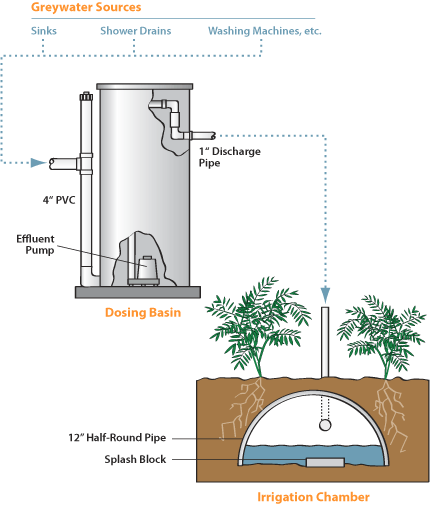 Greywater or Gray Water System Codes
Greywater or Gray Water System Codes
Regulations & Standards for Gray Water Systems
- POST a QUESTION or COMMENT about greywater systems
Graywater system regulations:
This article gives links to standards, codes & regulations for gray water systems.
This article series defines and explains the disposition of greywater, a type of wastewater.
Greywater is wastewater which does not contain sewage, typically coming from building sinks, showers, and laundry facilities. Graywater systems can reduce the load on or size of a septic system, and gray water separation, filtration, storage, and piping systems can conserve water, for recycling for various uses such as flushing toilets, landscaping, or irrigation.
InspectAPedia tolerates no conflicts of interest. We have no relationship with advertisers, products, or services discussed at this website.
- Daniel Friedman, Publisher/Editor/Author - See WHO ARE WE?
Grey Water System Codes & Regulations
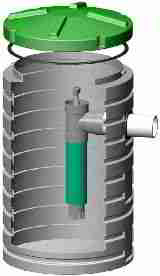
[Click to enlarge any image]
U.S. State Graywater System Regulations
Also use your browser's on-page search function [ Ctrl-F ] to search our directory by zipcode, city, or inspector's name
AK AL - AR - AZ - CA - CO - CT - DC - DE - FL - GA - HI - IA - ID - IL - IN - KS - KY - LA - MA - MD - ME - MI - MN - MO - MS - MT - NC - ND - NE - NH - NM - NV - NJ - NY - OH - OK - OR - PA - RI - SC - SD - TN - TX - UT - VA - VT - WA - WI - WV - WY
CANADA - separate directory
- Alaska Alabama Arkansas
- Arizona graywater regulations:
- ARIZONA GREY WATER REGULATIONS: [PDF] web search 01/24/2011, original source: http://www.azsos.gov/Public_services/Title_18/18-09.htm
Also see
Gelt, J. 2007. Home use of graywater, rainwater conserves water—and may save money. University of Arizona Water Resources Research Center. http://ag.arizona.edu/AZWATER/arroyo/071rain.html
- ARIZONA GREY WATER REGULATIONS: [PDF] web search 01/24/2011, original source: http://www.azsos.gov/Public_services/Title_18/18-09.htm
- California gray water code
- CALIFORNIA DRY WELLS USE REGULATIONS GUIDELINES [PDF] retrieved 2017/05/30, original source: http://www.waterboards.ca.gov/board_reference/2014fall/docs/dry_wells_fs.pdf
- CALIFORNIA GRAYWATER REGULATIONS: web search 01/24/2011, original source: http://www.hcd.ca.gov/codes/shl/2007CPC_Graywater_Complete_2-2-10.pdf.
Adaptign and quoting from the Certificate of Compliance with Final Express Terms Filed with the Secretary of State on January 27, 2010 [http://www.hcd.ca.gov/codes/shl/2007CPC_Graywater_Complete_2-2-10.pdf],
Chapter 16A of the California Plumbing Code establishes the minimum requirements for the installation of graywater systems in occupancies regulated by the Department of Housing and Community Development (HCD). It is intended to provide guideance to code users while providing flexibility to encourage the use of graywater.
This chapter contains provisions which allow the installation of limited types of graywater systems to be installed without a construction permit. It is not the intent of HCD that the exemption from a construction permit be construed by code users as an exemption from the provisions of this chapter or any other lawfully enacted requirements imposed by a city, county, or city and county, nor does it eliminate the need for persons considering the installation of a graywater system from contacting local authorities to ensure that they are adequately informed about any local requirements or prohibitions.
To READ THE PDFs listed below and then RETURN HERE, USE THE BACK ARROW OF YOUR BROWSER - 2016 California, Title 24, Part 5, Chapter 16A, Part I - Non potable Water Reuse System, [PDF] California Graywater Re-Use Code, retrieved 2017/08/02, original source: https://www.documents.dgs.ca.gov/bsc/2016InterCycle/1-Precycle%20Activities/AB-2282Workshop3/BSC-ET-Pt5-AB-2282.pdf
- CALIFORNIA GRAYWATER SYSTEM CODE 2007 [PDF] CPC, Title 24, Part 5, Chapter 16A, Part I - Non potable Water Reuse System, retrieved 2017/08/02, original source: http://www.hcd.ca.gov/building-standards/building-code/docs/Preface_ET_Emergency_Graywater.pdf
- CALIFORNIA GRAYWATER GUIDE [PDF] California state government, retrieved 2018/09/02, original source: https://water.ca.gov/LegacyFiles/wateruseefficiency/docs/graywater_guide_book.pdf
Excerpts:
Graywater is untreated household waste water which has not come into contact with toilet waste. Includes: used water from bathtubs, showers, bathroom wash basins, and water from clothes washing machines and laundry tubs. Does not include: waste water from kitchen sinks, dishwashers, or laundry water from soiled diapers.
California's Graywater Standards are now part of the State Plumbing Code, making it legal to use graywater everywhere in California. These standards were developed and adopted in response to Assembly Bill 3518, the Graywater Systems for Single Family Residences Act of 1992.
This Guide was prepared to help homeowners and landscape and plumbing contractors understand the Graywater Standards and to help them design, install and maintain graywater systems. Carlos Madrid Chief, Division of Local Assistance - CALIFORNIA GRAYWATER USES ALLOWED [PDF], San Diego Califorinia Water Authority, CA, retrieved 2018/09/02, original source: https://www.sdcwa.org/sites/default/files/files/water-management/recycled/uses-of-recycled-water-new.pdf
- CALIFORNIA GRAYWATER FACT SHEET [PDF] San Diego County Water Authority, California, retrieved 2018/09/02, original source: https://www.sdcwa.org/sites/default/files/graywater_guidelines.pdf
Excerpts:
How can I use Graywater? ow can I use Graywater? Graywater can be used to irrigate landscaping and plants but not on root crops or edible parts of food crops. Irrigati on lines can be either drip or leach systems and the discharge point must be covered by at least two (2) inches of mulch, rock, soil, or a solid shield to minimize the possibility of contact with humans and domesti c pets.
Be aware that some soaps and detergents can contain a variety of chemicals to aid in cleaning that may be harmful to your plants. Avoid soaps with chlorine or bleach, peroxygen, sodium perborate, sodium trypochorite, boron, borax, petroleum disti llate, alkylbenze, “whiteners”, “soft eners”, and enzymati c components. Please contact a reputable landscape specialist for more information.
What regulations should I know about?
What regulations should I know about? On January 27, 2010, the State of California fi nalized the graywater regulati ons for Chapter 16A “Nonpotable Water Reuse Systems” into the 2007 California Plumbing Code (CPC). The emergency graywater regulati ons were enacted to help residents of California conserve water by facilitati ng greater reuse of laundry, shower water, and similar sources for irrigati on.
In addition, by making legal compliance easy, the State hopes to reduce the number of non-compliant graywater systems. Your graywater system must comply with the 2007 CPC and other codes enacted by your local municipality or water purveyor. - CALIFORNIA REVISED GRAYWATER STANDARDS [PDF] (1997) California State Government, retrieved 2018/09/02, original source: https://water.ca.gov/LegacyFiles/wateruseefficiency/docs/Revised_Graywater_Standards.pdf
This is an historical document that contains useful graywater system design information and drawings - Finding of Emergency for Proposed Building Standards of the Department of Housing and Community Development regarding the 2007 California Plumbing Code (CPC), California Code of Regulations Title 24, Part 5 (Graywater Standards). [State of emergency in California in 2009 due to drought conditions]
- Initial Statement of Reasons for Proposed Emergency Building Standards of the Department of Housing and Community Development regarding the 2007 California Plumbing Code (CPC), California Code of Regulations Title 24, Part 5 (Graywater Standards)
- Nine-Point Criteria Analysis of Proposed Emergency Building Standards of the Department of Housing and Community Development Regarding the 2007 California Plumbing Code (CPC), California Code of Regulations Title 24, Part 5, Chapter 15A, Part 1 (Graywater Standards). Nine points that define the process of approval of building standards submitted to the CA Building Standards Commission.
- California Plumbing Code Chapter 16-A - Nonpotable Water Reuse Systems, Part I, Graywater Systems, Matrix Adoption Table
- Colorado: Graywater Design Suggestions: water.state.co.us/pubs/policies/waterharvesting.pdf discusses rainwater harvesting and graywater systems in Colorado
- Connecticut
- District of Columbia
- Delaware
- Florida Gray Water Regulations
- FLORIDA GRAYWATER REGULATIONS, [PDF] References, & Building Codes:
- Florida Building Code. 2007. Florida Building Code: Plumbing, Effective March 1, 2009. http://www.floridabuilding.org/
- Florida Building Code. 2009. 2009 Supplement to the 2007 Florida Building Code, Effective March 1, 2009. http://www.floridabuilding.org/
- Florida Department of Health. 2006. Chapter 64E-6, Florida Administrative Code, Standards for Onsite Sewage Treatment and Disposal Systems, [Large PDF] web search 01/24/2011, original source: http://www.doh.state.fl.us/ENVIRONMENT/OSTDS/pdfiles/forms/64e6.pdf
- Florida Wastewater Processing & Conservation Practices, Jake Emerson, University of Florida, web search 01/24/2011, original source: www.cce.ufl.edu/wastewater
- Georgia Hawaii Iowa Idaho Illinois Indiana Kansas Kentucky Maryland Maine
- Louisiana Grawater Regulations, Contact the Louisiana DEQ at www.deq.louisiana.gov
- Massachusetts Graywater Regulations: In MA, Greywater is subject to the following (310 CMR 15.262):
- Allows greywater systems for new construction: residential facilities need to demonstrate that a fully complying system can be installed.
- Reduces the septic tank size to 1000 gallons for residential systems. Septic tanks for commercial and public facilities shall be at least two thirds the size of a septic tank based on the design flows presented in 310 CMR 15.203. An effluent filter system specifically approved by MassDEP and/or the State Board of Plumbers and Gas Fitters for this use may be used in place of the septic tank.
- Greywater systems for new construction or increase in flows must comply with the nitrogen loading requirements of 440 gallons per acre.
- Provides an allowable nitrogen loading rate for residential facilities of 660 gallons per acre and up to 770 gallons per acre on a case-by-case as determined by the Department for commercial and public facilities provided there is no discharge of blackwater and the compost is disposed off-site.
- Allows a 50% reduction in the SAS when a composting toilet is used.
- Requires nine inches of cover over the SAS.
- For remedial upgrades the groundwater separation may be reduced to 2 feet where the percolation rate is greater than 2 mpi or 3 feet where the percolation rate is 2 mpi or less.
- Source: Retrieved 5/15/14, original source: http://www.mass.gov/eea/agencies/massdep/water/wastewater/ regulatory-provisions-for-compost-toilets-and-greywater.html
Massachusetts also regulates the use of humus / composting toilets
- Michigan
- Minnesota statuyes on Graywater: See Minnesota Statutes:
- Mionnesota Rules 7080.2204 Graywater Systems found in Minnesota Rules, Chapters 7080-7083, Subsurface Sewage Treatment Programs, Chapter 7080 Minnesota Pollution Control Agency Design Standards for .... Graywater Systems - beginning on p. 54
- Minnesota Section 97A.015, Chapter 97A Game and Fish (2013 and earlier)
- Minnesota 115.59 Advanced Treatment Systems
- Missouri Mississippi Montana
- New Jersey Graywater & Drywell Regulations
- NEW JERSEY DRY WELL REGULATIONS 9.3 (stormwater) [PDF]
- NEW JERSEY DRYWELL STANDARD 9.3 [PDF] retrieved 2017/05/30, original source: http://www.nj.gov/dep/stormwater/bmp_manual/NJ_SWBMP_9.3%20print.pdf
- NEW JERSEY STORMWATER BEST PRACTICES MANUAL [PDF], retrieved 2017/05/30, original source: http://www.nj.gov/dep/stormwater/bmp_manual/NJ_SWBMP_9.3%20print.pdf
- NEW JERSEY WELL CONSTRUCTION, MAINTENANCE, SEAL ABANDONED WELLS [PDF] retrieved 2017/05/30, original source: http://www.nj.gov/dep/rules/rules/njac7_9d.pdf
- New Mexico Gray Water Regulations
- New Mexico Gray Water Guide, http://www.ose.state.nm.us/water-info/conservation/pdf-manuals/NewMexGWGuide.pdf - NOTE: this is a particularly helpful document, recommended reading - Ed.
- web search 01/24/2011, original source: http://www.nmlegis.gov/Sessions/05%20Regular/bills/house/HB0711.pdf
- New York Gray water regulations:
- "Potentia! Reuses Greywater and Recfaimed IYastewaler in New York State
issued pursuant to Chapter 619 of the Laws of 2005", (2010) http://www.dec.ny.gov/docs/water_pdf/waterresue.pdf - McCabe, Shane, "Breaking Down Policy Barriers for Residential Graywaer Installation and Usage in New York City", Pratt Institute/PSPD Environmental Systems Management Capstone, (2013) http://prattpspd.com/wp-content/uploads/2013/04/McCabeShane_GreywaterCapstone.pdf
- "Potentia! Reuses Greywater and Recfaimed IYastewaler in New York State
- North Carolina North Dakota Nebraska New Hampshire Nevada Ohio Okalahoma Oregon Pennsylvania Rhode Island
- South Carolina South Dakota Tennessee
- Texas graywater codes
- TEXAS GREYWATER REGULATIONS: Texas Health & Safety Code - Section 341.039. Graywater Standards, web search 01/24/2011, original source: http://law.onecle.com/texas/health/341.039.00.html
- Utah: Graywater Systems Design Standards: "R317. Environmental Quality, Water Quality. Rule R317-401. Graywater Systems. As in effect on April 1, 2014", www.rules.utah.gov/publicat/code/r317/r317-401.htm
- Vermont
- Virginia Graywater Guidelines: a permit issued by the Virginia State Health Commissioner must be obtained before installing and using a gray water system, submitted through your local health department.
Virginia law ENV-663, Gray Water Guidelines, February 1999,
§32.1-248.2 can be read at https://www.vdh.virginia.gov/EnvironmentalHealth/ONSITE/regulations/FormsDocs/documents/2010/ pdfs/Graywater%20Use%20guidelines%20by%20VDH_feb99.pdf - Washington State Graywater Systems Regulations:
- The whole Washington State Graywater Regulation law is at
http://apps.leg.wa.gov/WAC/default.aspx?cite=246-274&full=true - Also see this Washington State graywater study:
http://www.doh.wa.gov/Portals/1/Documents/Pubs/337-108.pdf
- The whole Washington State Graywater Regulation law is at
- Wisconsin West Virginia Wyoming
Graywater System Products, Greywater Diversion Systems, Pumps, Tanks, Books and Design Specifications For Graywater Systems
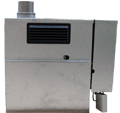
- BUY GREYWATER BOOKS ONLINE
- Create An Oasis with Greywater, Art Ludwig. Also see Ludwig's "Branched Drain Greywater Systems" and his "Building Professional's Greywater Guide".
- Greywater Recycling Kits & Equipment from The Natural Home Building Source: http://www.thenaturalhome.com/greywater.html
- Graywater Central - online web with design information http://www.graywater.net/
- Access Water Energy, PO Box 2061, Moorabbin, VIC 3189, Australia, Tel: 1300 797 758, email: sales@accesswater.com.au Moorabbin Office: Kingston Trade Centre, 100 Cochranes Rd, Moorabbin, VIC 3189
Australian supplier of: Greywater systems, Solar power to grid packages, Edwards solar systems, Vulcan compact solar systems, water & solar system pumps & controls, and a wide rage of above ground & under ground water storage tanks: concrete, steel, plastic, modular, and bladder storage tanks. - Aqua2use Grey Water System (GWDD), Water Wise Group, Inc., 1580 Granache Way, Templeton, CA 93465, Phone: (805) 468-4920 Remy Sabiani - remy@waterwisegroup.com
- Eco John describes two incinerating toilet models: EcoJohn Sr - "A highly efficient, waterless toilet that incinerates the waste with propane. This is a toilet that is ideal for cabins, pool houses, guest rooms, or other remote areas where a conventional toilet is not available or too costly to install."
and EcoJohn Jr Pr1 System "
This is a new revolutionary system that incinerates gray/black water from a holding tank. This system is perfect in areas where a water toilet is needed, but pumping out the waste is problematic or too costly." This grey water and waterless toilet system that includes an incinerator for graywater that marries with a low-water toilet, the the EcoJohn Jr which is includes a sewage and graywater incinerating unit. The EcoJohn Jr. uses a low-flush toilet (not a waterless toilet). This is an incinerating unit not a composting toilet and not a chemical toilet system.
Also see TOILETS, WATERLESS ALTERNATIVES
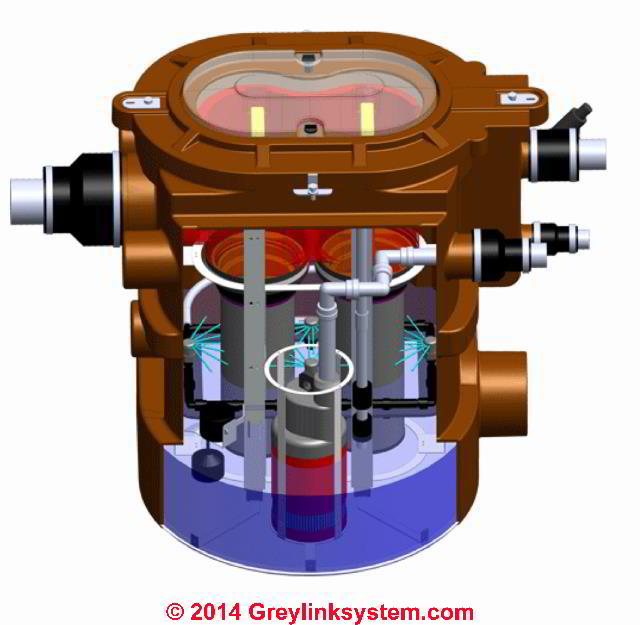
- FLOTENDER GREYWATER IRRIGATION SYSTEMS- We manufacture greywater irrigation systems. Contact information is given below at GreyLink. Quoting the company's product description:
Flotender is designed for one or two zone irrigation systems where a portion of the landscape is to be irrigated with greywater. Flotender and GreyLink include nearly identical greywater processors with the only difference being the omission of an auto-fill sensor in the Flotender models.
Image at left illlustrates GreyLink's self-cleaning greywater filter. [Click to enlarge any image]
- GREYLINK GREYWATER IRRIGATION SYSTEMS - quoting from the company's website:
GreyLink is the "whole landscape greywater irrigation solution." GreyLink's integrated feature set provides advanced reporting and precise control over the irrigation system while delivering substantial water savings. GreyLink is best utilized when the goal is to utilize greywater on an entire medium to large sized landscape.
- Filtrific Water Feature Equipment & Greylink Greywater Irrigation Systems
- GreyLink™ by Filtrific®, 13212 NE 16th St., Suite 101, Bellevue, WA 98005
- Tel: 800.906.0604 - Fax: 425.482.9559
- Email: support@greylinksystem.com
- Website: http://www.filtrific.com
- Website: http://www.greylinksystem.com
- Website: http://www.flotender.com
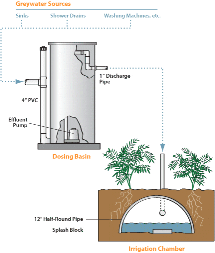
- CLIVIS MULTRUM greywater systems use a holding chamber, effluent pump,
and an onsite irrigation chamber (see our Gravelless septic system components information) to dispose of graywater.
The sketch of a greywater handling and disposal system shown here is from the Clivus Multrum website where more details of system operation are provided. Where soil conditions and site space permit onsite graywater disposal this system design can significantly reduce the wastewater load on the septic or "blackwater" system.
Clivus Multrum has long experience with composting toilets (CM was an early designer of composting toilets) and greywater disposal systems. - Builder's Greywater Guide, Art Ludwig. Oasis Design, 2006, ISBN-10: 0964343320 ISBN-13: 978-0964343320
- Create an Oasis with Greywater, Choosing, Building, and Using Greywater Systems - includes Branched Drains, Art Ludwig, Oasis Design, 2006, ISBN 0964343398
- the Culture of Technology, Arnold Pacey,
- Effects of Water Age on Distribution System Water Quality, American Water Works Association.
- Ferrocement Water Tank, Frans Dubbeldam. German Volunteer Service in Nepal
- Ferrocement Water Tanks and their Construction, S.B. Watt, printed by the Intermediate Technology Publications, London, UK.
- Gravity Flow Water Systems: Handbook of Gravity Flow Water Systems Thomas D. Jordan, Jr. Intermediate Technology Development Group. 1980.
- Maruata en el Cruce de Caminos, Art Ludwig. Oasis Design. Ecological systems designs for an indigenous community in Mexico, including water supply and sanitation. See PDF downloadable book at www.oasisdesign.net/design/examples/maruata/book.htm
- "Microbial Problems in Treated Water Storage Tanks", Smith, C., and G. Burlingame. 1994. In Proc. of the 1994 Annual AWWA Conference. Denver, Colo.: AWWA.
- The Toilet Papers: Designs to Recycle Human Waste and Water : Dry Toilets, Greywater Systems and Urban Sewage (Paperback) Sim Van Der Ryn, Wendell Berry; Quoting from an Amazon review:
With a title like "Toilet Papers" and from a distinguished eco-architect like Sim Van der Ryn, I needed no intro or review to buy a copy of this little, but well researched historical over-view of effluent mitigation and current eco-friendly toilet design.
This book is filled with good line drawings and photographs to depict everything from the historical perspective to the current dry toilets and their construction.. - Quality of Water in Storage Grayman, W.M. and G.J. Kirmeyer. 2000. "Protecting Your Storage Tank - An Analysis of Long- and Short-Term Options", Jacobs, K.A. 2000. In Proc. of the AWWA Infrastructure Conference. Denver, Colo.: AWWA.
- Rainwater Catchment Systems for Domestic Supply, John Gould and Erik Nissen-Petersen. Intermediate Technology Publications, 1999.
- Sand filters See www.oasisdesign.net/water/treatment/slowsandfilter.htm
- CONTACT US to list your product or service here - if you are a manufacturer of composting toilets or other alternative wastewater treatment system equipment your product may be listed at no fee. Website content critique, additions, and suggestions are also invited.
...
Reader Comments, Questions & Answers About The Article Above
Below you will find questions and answers previously posted on this page at its page bottom reader comment box.
Reader Q&A - also see RECOMMENDED ARTICLES & FAQs
Question: Does Washington State prohibit graywater systems?
I am having issues with my septic system and the service that has started my job is telling me that in Washington State it is a state law that we cannot use Grey Water systems.
Do you happen to know anything about that? I am very interested in adding a system like yours for my home. Please let me know. Thank you - D.W. 5/15/2014
Reply:
Washington State does not prohibit graywater re-use but does specify guidelines and the state allows local jurisdictions to enforce more strict regulation. Indeed the state has published various studies and guidelines.
Quoting from your state's own publicationsChapter 246-274 WAC sets requirements for using greywater for subsurface irrigation.
The rule took effect on July 31, 2011. Local health jurisdictions (LHJs) have three years to implement it.
(LHJs may adopt more stringent requirements than those in the state rule.) However, if they are unable to adjust resources to implement and enforce this chapter, the provisions of chapter 246-272A WAC shall continue to apply to greywater reuse for subsurface irrigation.
Check with your LHJ to learn if greywater reuse under chapter 246-274 WAC is allowed or ask them how to support that effort if it is not allowed yet.
Watch out: Washington State authorities (and the WA law), in discussing the re-use of graywater and the design of graywater systems does make clear that installing a graywater re-use sysem does not exclude septic systems (onsite wastewater disposal systems or soakawy beds or soakpits depending on where you live) from meeting other state requirements for those systems.
In other words, if your septic system needs a new drainfield, it will still need one after installing a graywater re-use system.
However on occasion one can extend the life of a septic drainfield by reducing the water load on it by routing graywater elsewhere.
On 2019-06-06 by Judith - is it OK if clothes washing machine discharges wastewater onto the lawn?
My rental house has a PVC pipe coming outside the house to drain used water from our clothes washing machine. The landlord has it emptying onto the lawn on the side of our house, not connected to the septic tank. Is that ok.
On 2019-06-06 by (mod) - NO
@Judith
You'll see in just about any model or municipal plumbing and septic code that it is improper, usually illegal, to simply discharge wastewater onto the ground surface.
You can see that in graywater codes on this page and more
at SEPTIC & SEWAGE TREATMENT CODES & REFERENCES
But that's not to say that reclaiming and re-using graywater, including for irrigation is illegal or improper.
See details about proper handling, disposal, or use of graywater in the Recommended Articles at the end of this page.
...
Continue reading at GREYWATER SYSTEM PRODUCTS, SUPPLIERS or select a topic from the closely-related articles below, or see the complete ARTICLE INDEX.
Or see these
Recommended Articles
- ALTERNATIVE & WATERLESS TOILETS other graywater systems such as toilet tank top mounted sinks that feed graywater directly into the toilet flush tank.
- FILTERS SEPTIC & GREYWATER used to protect septic systems from debris in graywater, the first step in making graywater useful for watering grass, trees, plants, etc.
- GREYWATER SYSTEMS - home
- CISTERN & RAINWATER COLLECTION SYSTEMS- a combination of rainwater collection and graywater collection, diversion, re-use on a home built in an area of water scarcity
- DEFINITION of GRAYWATER SYSTEMS
- FILTERS SEPTIC & GREYWATER
- GREYWATER DISINFECTION BEFORE RE-USE
- GREYWATER FREEZE PROTECTION
- GREYWATER CODES & REGULATIONS
- GREYWATER FLUSH TOILETS
- GREYWATER RE-USE & RAINWATER COLLECTION SYSTEMS
- GREYWATER SYSTEM PRODUCTS, SUPPLIERS
- TYPES of GRAYWATER SYTEMS PRODUCTS
- USE GRAYWATER to REDUCE SEPTIC LOAD
- WATER CONSERVATION MEASURES
Suggested citation for this web page
GREYWATER CODES & REGULATIONS found at InspectApedia.com - online encyclopedia of building & environmental inspection, testing, diagnosis, repair, & problem prevention advice.
Or see this
INDEX to RELATED ARTICLES: ARTICLE INDEX to SEPTIC SYSTEMS
Or use the SEARCH BOX found below to Ask a Question or Search InspectApedia
Ask a Question or Search InspectApedia
Try the search box just below, or if you prefer, post a question or comment in the Comments box below and we will respond promptly.
Search the InspectApedia website
Note: appearance of your Comment below may be delayed: if your comment contains an image, photograph, web link, or text that looks to the software as if it might be a web link, your posting will appear after it has been approved by a moderator. Apologies for the delay.
Only one image can be added per comment but you can post as many comments, and therefore images, as you like.
You will not receive a notification when a response to your question has been posted.
Please bookmark this page to make it easy for you to check back for our response.
Comments
IF above you see "Comment Form is loading comments..." then COMMENT BOX - countable.ca / bawkbox.com IS NOT WORKING.
In any case you are welcome to send an email directly to us at InspectApedia.com at editor@inspectApedia.com
We'll reply to you directly. Please help us help you by noting, in your email, the URL of the InspectApedia page where you wanted to comment.
Citations & References
In addition to any citations in the article above, a full list is available on request.
- New York State Department of Health, APPENDIX 75-A WASTEWATER TREATMENT STANDARDS - INDIVIDUAL HOUSEHOLD SYSTEMS , [PDF] New York State Department of Health, 3 February 2010, retrieved 3/1/2010, original source: https://www.health.ny.gov/regulations/nycrr/title_10/part_75/appendix_75-a.htm
- American Rainwater Cachment Systems Association (ARCSA),
823 Congress Avenue, Suite 230, Austin, TX 78701, 512-617-6528 Email: info@arcsa.org. Quoting from the association's website:
The Mission of the American Rainwater Catchment Systems Association is to promote sustainable rainwater harvesting practices to help solve potable, non-potable, stormwater and energy challenges throughout the world.
The American Rainwater Catchment Systems Association is a 501(c)(3) non-profit organization that was founded in 1994 by Dr. Hari J. Krishna in Austin, Texas, to promote rainwater catchment systems in the United States. Our memberships consist of professionals working in city, state, and federal government, academia, manufacturers and suppliers of rainwater harvesting equipment, consultants, and other interested individuals. Membership is not limited to the United States, and we encourage all rainwater harvesting enthusiasts to join our organization. Local responsibilities are often delegated to ARCSA's Regional Representatives. - Aqua2use Grey Water System (GWDD), Water Wise Group, Inc.
1580 Granache Way, Templeton, CA 93465, Phone: (805) 468-4920, Remy Sabiani, Email: remy@waterwisegroup.com.
Thanks to Mr. Sabiani for technical review and critique, 01/25/2011.
A YouTube video explains what greywater is, and how the Aqua2use works. - Winward, Gideon P., Lisa M. Avery, Tom Stephenson, and Bruce Jefferson. "Chlorine disinfection of grey water for reuse: Effect of organics and particles." Water research 42, no. 1 (2008): 483-491.
- Cawley, William E., and Basil W. Mercer. "Water recycle system." U.S. Patent 4,812,237, issued March 14, 1989.
Abstract:
A closed water purification and recycle system processes domestic wastewater to produce potable water for cooking, drinking and dishwashing and water suitable for general household use, such as washing clothes and personal hygiene. The system consists of septic tanks, a biological sand filter, an ultrafilter, a disinfection unit, pumps, valves, water quality and quantity sensors to monitor and control the process. The system also includes an incinerator toilet to eliminate the need for toilet flush water. Water for cooking, drinking and dishwashing is produced by a still using some of the recycled water for feed. The quality of the recycled water is monitored to assure the product water is suitable for the intended uses. Water thus produced is stored until reused. The system will be automatically shut down if the final product water quality does not meet specifications. Blowdown containing concentrated salts from the still is evaporated and incinerated in the incinerator toilet to maintain a satisfactory concentration of salts in the recycled water. The system equipment is designed and sized to allow unattended operation between inspections, scheduled periodically, at which time routine maintenance is performed and makeup water is added to the system to replace water lost to evaporation. - Graywater and Rainwater System Plans from Ecological Engineering
- Thanks to reader C.M. (California) for discussing greywater distribution devices, January 2011
- In addition to citations & references found in this article, see the research citations given at the end of the related articles found at our suggested
CONTINUE READING or RECOMMENDED ARTICLES.
- Carson, Dunlop & Associates Ltd., 120 Carlton Street Suite 407, Toronto ON M5A 4K2. Tel: (416) 964-9415 1-800-268-7070 Email: info@carsondunlop.com. Alan Carson is a past president of ASHI, the American Society of Home Inspectors.
Thanks to Alan Carson and Bob Dunlop, for permission for InspectAPedia to use text excerpts from The HOME REFERENCE BOOK - the Encyclopedia of Homes and to use illustrations from The ILLUSTRATED HOME .
Carson Dunlop Associates provides extensive home inspection education and report writing material. In gratitude we provide links to tsome Carson Dunlop Associates products and services.


No one has commented yet. Be the first!